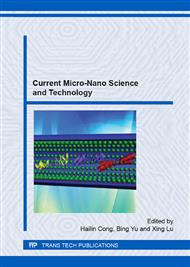[1]
B.N. Pal, Y. Ghosh, S. Brovelli, R. Laocharoensuk, V.I. Klimov, J.A. Hollingsworth, H. Htoon, Giant, CdSe/CdS core/shell nanocrystal quantum dots as efficient electroluminescent materials: strong influence of shell thickness on light-emitting diode performance, Nano Lett. 12 (2011).
DOI: 10.1021/nl203620f
Google Scholar
[2]
O.E. Semonin, J.M. Luther, S. Choi, H. Chen, J. Gao, A.J. Nozik, M.C. Beard, Peak external photocurrent quantum efficiency exceeding 100% via MEG in a quantum dot solar cell, Science. 334 (2011) 1530-1533.
DOI: 10.1126/science.1209845
Google Scholar
[3]
A. Gubenko, I. Krestnikov, D. Livshtis, S. Mikhrin, A. kovsh, L. West, C. Bornholdt, N. Grote, A. Zhukov, Error-free 10 Gbit/s transmission using individual Fabry-Perot modes of low-noise quantum-dot laser. Electron. Lett. 43 (2007) 1430-1431.
DOI: 10.1049/el:20072953
Google Scholar
[4]
W.W. Yu, E. Chang, R. Drezek, V.L. Colvin, Water-soluble quantum dots for biomedical applications, Biochem. Biophys. Res. Commun. 348 (2006) 781-786.
DOI: 10.1016/j.bbrc.2006.07.160
Google Scholar
[5]
J.M. Klostranec, W.C.W. Chan, Quantum dots in biological and biomedical research: recent progress and present challenges. Adv. Mater. 18 (2006) 1953-(1964).
DOI: 10.1002/adma.200500786
Google Scholar
[6]
A. de Kergommeaux, J. Faure-Vincent, A. Pron, R. de Bettignies, M. Bernard, R. Peter, Surface Oxidation of Tin Chalcogenide Nanocrystals Revealed by 119Sn–Mössbauer Spectroscopy. J. Am. Chem. Soc. 134 (2012) 11659-11666.
DOI: 10.1021/ja3033313
Google Scholar
[7]
H.J. Kim, D.J. Kim, S. Srinivasa Rao, A. Dennyson Savariraj, K. Soo-Kyoung, M.K. Son, C.V.V.M. Gopi, K. Prabakar, Highly efficient solution processed nanorice structured NiS counter electrode for quantum dot sensitized solar cells, Electrochim. Acta. 2014, 127: 427-432.
DOI: 10.1016/j.electacta.2014.02.019
Google Scholar
[8]
H.J. Kim, S.W. Kim, C.V.V. M Gopi, et al, Improved performance of quantum dot-sensitized solar cells adopting a highly efficient cobalt sulfide/nickel sulfide composite thin film counter electrode. J. Power Sources. 268 (2014) 163-170.
DOI: 10.1016/j.jpowsour.2014.06.007
Google Scholar
[9]
S.C. Han, K.W. Kim, H.J. Ahn, J.Y. Lee, Charge–discharge mechanism of mechanically alloyed NiS used as a cathode in rechargeable lithium batteries, J. Alloys Compd. 361 (2003) 247-251.
DOI: 10.1016/s0925-8388(03)00380-3
Google Scholar
[10]
T. Zhu, H.B. Wu, Y. Wang, R. Xu, X.W. Lou, Formation of 1D hierarchical structures composed of Ni3S2 nanosheets on CNTs backbone for supercapacitors and photocatalytic H2 production, Adv. Eng. Mater. 2 (2012) 1497-1502.
DOI: 10.1002/aenm.201200269
Google Scholar
[11]
J.J. Wang, Z.J. Li, X.B. Li, X.B. Fan, Q.Y. Meng, S. Yu, C.B. Li, J.X. Li,C.H. Tung, L.Z. Wu, Photocatalytic Hydrogen Evolution from Glycerol and Water over Nickel‐Hybrid Cadmium Sulfide Quantum Dots under Visible‐Light Irradiation, ChemSusChem. 7 (2014).
DOI: 10.1002/cssc.201400028
Google Scholar
[12]
J.Z. Wang, S.L. Chou, S.Y. Chew, J.Z. Sun, M. Forsyth, D.R. MacFarlane, H.K. Liu, Nickel sulfide cathode in combination with an ionic liquid-based electrolyte for rechargeable lithium batteries, Solid State Ionics. 179 (2008) 2379-2382.
DOI: 10.1016/j.ssi.2008.09.007
Google Scholar
[13]
P. Samokhvalov, M. Artemyev, I. Nabiev, Basic principles and current trends in colloidal synthesis of highly luminescent semiconductor nanocrystals, Chem. Eur. J. 19 (2013) 1534-1546.
DOI: 10.1002/chem.201202860
Google Scholar


